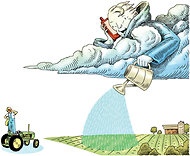NEW YORK TIMES
By RANDALL STROSS
 THE world doesn’t necessarily need the gazillion-and-one games that seem available on smartphones. But it could use more apps and services that address the needs of business people with specialized needs. Like farmers
THE world doesn’t necessarily need the gazillion-and-one games that seem available on smartphones. But it could use more apps and services that address the needs of business people with specialized needs. Like farmers
Wesley Bedrosian
FarmLogs, a start-up based in Ann Arbor, Mich., is a one of a few new companies that are making a pitch to farmers. It offers a cloud-based software service — no software is downloaded; only a Web browser is needed — that embodies the latest technology. But in reaching its intended customers, the company must often rely on an old-fashioned medium: in-person selling.
Jesse Vollmar, 23, and Brad Koch, 22, graduated fromSaginaw Valley State University last year and were running their own small I.T. consulting company when they decided to try to make easy-to-use software for farms like the one on which Mr. Vollmar grew up in Caro, Mich., about 90 miles northwest of Detroit.
The two received funding from Y Combinator, a seed fund in Mountain View, Calif. During a three-month residency in Silicon Valley last winter, under Y Combinator’s aegis, they worked on farm management software aimed at tracking all of a farmer’s field activities. In one view, a farmer can see rectangular representations of what is planted on each field. A click leads to a log of what was done when on each field: tilling on this date, fertilizing on that date, spraying on another.
With the data stored in one place, it can be combined with information from other sources and used by the farmers. If they need, they can also share it easily with consulting agronomists, crop insurance agents, the Agriculture Department and others.
Nathan Engelhard, an early customer who farms 1,000 acres in Unionville, Mich., says FarmLogs gives him the ability to take his iPad out into the field and make entries himself. “FarmLogs is a money saver,” he says, “because I don’t have to write things down on a scrap of paper and pay someone to sit in an office and enter them into the computer.”
FarmLogs officially opened to customers in June. “We’re trying to reach a community that isn’t all online yet,” Mr. Vollmar says. “We have to use more traditional marketing methods.” FarmLogs declined to say how many people have signed up.
In mid-July, Mr. Vollmar set up a booth at a local county fair. (In the booth to the left was a political candidate; to the right, a psychic.) Farmers who stopped by were receptive, and many signed up for the service, he says. But the local fair drew too few attendees.
FarmLogs reached many more prospects by demonstrating its service at a booth at the much larger Ag Expo at Michigan State University. This annual agricultural trade show drew more than 18,000 visitors last month.
FARMLOGS has spent little on advertising. Print magazines about farming are often found in rural homes, but the company has not yet tested the efficacy of print ads, which Mr. Vollmar says are costly. Instead, experiments with Google ads have produced encouraging results, especially when tied to a search for the phrase “farm management software.”
In a niche like this, the pre-cloud method of software distribution, entailing downloading and installing software on a desktop PC, imposes high initial costs for the customer, but no monthly fees. One of FarmLogs’ older competitors, Farm Works Software, for example, sells accounting software for a desktop PC that is designed for farmers and costs $750.
FarmLogs, however, uses the pricing format of software-as-a-service start-up: a free trial, no setup fees, and monthly plans based on the size of operations. Costs range from $9 a month for the smallest farm to $99 a month for farms of more than 2,000 acres.
Farmers’ income arrives unevenly, in big lumps over the course of a year rather than in a steady monthly stream. That could make it hard to persuade farmers who are now using notebooks or spreadsheets for record-keeping to add a new and recurring expense category, software-as-a-service, even if the amount is tiny when compared with annual income.
Another start-up, Farmeron, also provides a cloud-based software service for farm management. It has received funding from 500 Startups, another seed fund based in Mountain View.
But where FarmLogs is for row crops, Farmeron is focused on livestock management. Its monthly charge depends on the number of animals managed by the farm, and by the number of people who use the software. Typically, of the many people who may work on a farm, two or more may need simultaneous access to the same data, which a cloud-based service easily provides.
The mission of another start-up, Solum, is to expand the store of data that farmers use to make decisions. The company has a central office in Mountain View and a soil analysis laboratory in Ames, Iowa.
Founded by three young men who earned Ph.D.’s in applied physics from Stanford, Solum has created new hardware and software technology for soil analysis. It makes a machine for testing soil nitrate levels that is small enough to be kept on the farm, allowing farmers to perform far more tests cost-effectively in a given field, says Nick Koshnick, one of the founders.
“It turns out that there’s huge variability in yield across a field,” Mr. Koshnick says, “The challenge is to figure out what accounts for the variability. Our soil analysis can be used with GPS mapping to help agronomists figure out what fertilizer to put where.”
In essence, Solum and other start-ups are building the technology to allow farmers to benefit from data science.
Solum has raised more than $19 million from investors including the Silicon Valley venture capital firms Khosla Ventures and Andreessen Horowitz.
Had it been around in his day, George Washington might have been quite excited to see a demonstration of Solum’s testing technology. At Mount Vernon, Washington experimented with using muck dredged from the Potomac River as a fertilizer — he would toast, “Success to the mud!” But his method, alas, was hit-or-miss. No GPS, databases or algorithms, and no software-as-a-service at any price.






